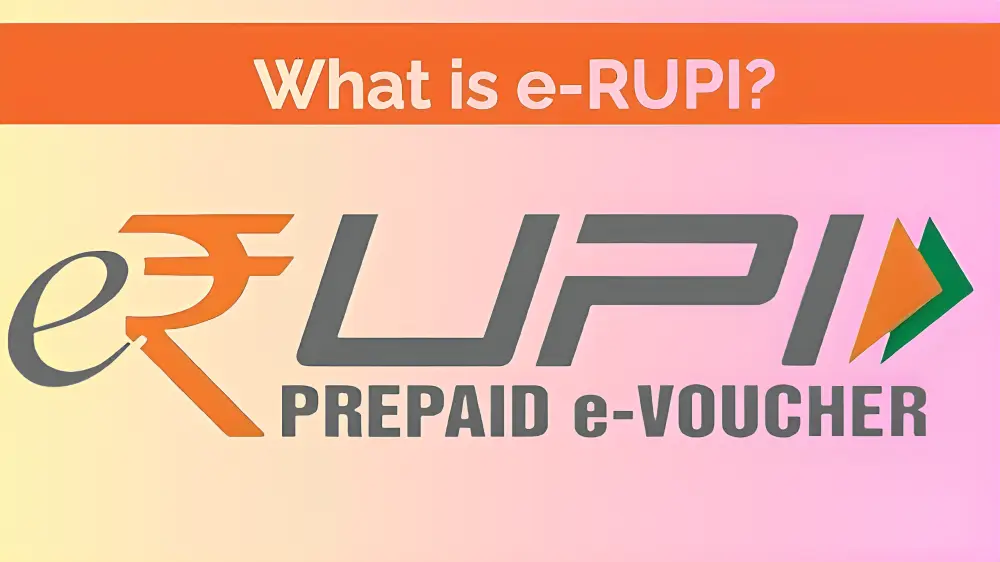It is anticipated that the creation of a digital currency will begin with the “What is E Rupi” electronic payment system, which is based on digital vouchers. It seems that the Indian government has devised a plan to utilize digital infrastructure to guarantee the delivery of its welfare packages without any leaks. The idea is straightforward and is applied in the US, Hong Kong, and several other nations: pre-paid coupons with specific purposes. India is leading the way in fintech and, true to its proclivity for techno-solutionism, it is following suit with the introduction of a new payment system.
What is E Rupi? Definition
e-RUPI is an entirely cashless and contactless electronic payment method that will be sent as an SMS-based e-voucher or a QR code to the recipient’s mobile devices (including non-Android or iOS devices). In its most basic form, it works like a coupon that can be used to receive particular services without further verification or paperwork.
e-RUPI offers beneficiaries an easy and convenient way to redeem government services, considering a significant portion of the Indian population lacks access to banking or the internet. You don’t need a bank account, a card, or even to install an app for digital payments to use the e-RUPI voucher. The pre-allotted amount associated with the QR codes or SMS vouchers can only be used once by the person whose name they were issued. Importantly, the beneficiary must first take advantage of the applicable service or services before the payment can be finalized.
Digital E-Rupi: How It Works
The beneficiary receives an SMS or QR code in the form of an e-RUPI digital voucher on his mobile device. The pre-paid voucher can be redeemed at participating centers and is in the form of a voucher. Recipients can use it as a one-time contactless, cashless voucher-based payment method without a card, digital payments app, or internet banking access. The digital currency that the Reserve Bank of India is considering is not the same as e-RUPI.
Digital E-Rupi: Advantages
The beneficiary doesn’t need to have a bank account. Because it makes sure that the two-step redemption process is simple, contactless, and requires no sharing of personal information. The best thing about e-RUPI is that it can run off a simple phone and no internet connection.
The beneficiary can make financial transactions using the e-RUPI payment solution even if they don’t have an account. It would be possible for higher uptake in rural areas and among those with low incomes due to this system’s flexibility.
Additionally, there is a great chance to directly help small businesses through several government initiatives. This would help the poor achieve their long-term financial goals and means of subsistence.
It will facilitate the nation’s citizens’ financial integration. It will also guarantee leak-free, efficient, and transparent outreach by public services to lists-mile customers.
The e-RUPI solution is easy to use and secure at the same time. Therefore, this technology will be beneficial to those who lack literacy.
How is e-RUPI Different From UPI?
While there are other ways to transfer money or make payments, the electronic rupee (e-Rupee) and UPI programs like Google Pay, PhonePe, NEFT, and IMPS are forms of sovereign money. The digital rupee is a legal tender that isn’t backed by actual money, but UPI transactions are fully supported by actual currency. This is the main difference.
Bank intermediation is a part of every UPI transaction. Money is transferred to the recipient’s bank and your bank account is debited when you use a UPI app. You can keep paper money in your wallet, take out a set amount from the bank, and use it anywhere that banks wouldn’t know about.
Similarly, you will take out and store digital currency in your mobile wallet using e-RUPI. Money goes from your digital wallet to the recipient’s when you make a transfer to them. Bank routing and intermediation are absent.
How Does e-RUPI Operate?
- To issue e-RUPI, the corporate/government department (Sponsor) provides the issuer bank with information (name, phone number, amount, reason for the voucher, expiration date, etc.).
- To establish an e-RUPI, the issuer bank or payer PSP notifies the NPCI (National Payments Corporation of India).
- The Issuing Bank/Payer PSP receives a success confirmation notification from NPCI. After the corporate or governmental entity receives certification from the issuer bank or payer PSP for e-RUPI generation, it will send the QR code or SMS string to the recipient.
- Beneficiary makes redemption-related contact with the merchant via e-RUPI. Retailers verify e-RUPI coupons, evaluate the recipients, and initiate redemption requests.
- After a successful redemption confirmation, the merchant provides the recipient with the service.
Digital E-Rupi: Banks That Issue It
- Axis Bank
- HDFC Bank
- ICICI Bank
- Indian Bank
- Canara Bank
- IndusInd Bank
- Bank of Baroda
- Union Bank of India
- Kotak Mahindra Bank
- Punjab National Bank
- State Bank of India
Conclusion
What is E Rupi, which provides a safe, effective, and open platform for financial transactions, signifies a paradigm shift in the way we view digital payments. Technology has the power to change millions of lives and open the door to a more inclusive and sustainable future by addressing problems in the real world. As we enter the digital era, E-Rupi is positioned to be a major force in forming the future digital economy.
